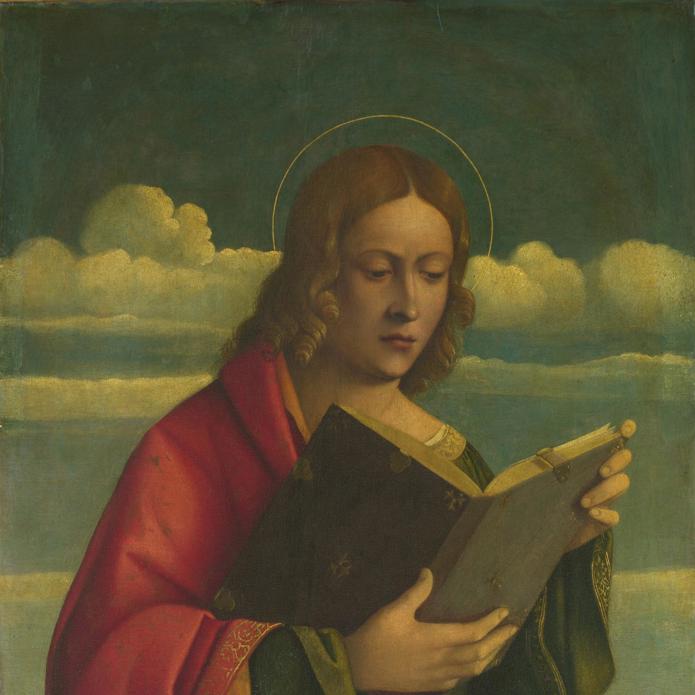Girolamo da Santacroce, 'A Saint with a Fortress and a Banner', probably about 1512-25
About the work
Overview
This young saint holding a banner and a model fortress was once thought to be Saint George, as a red cross on a white background is the flag associated with him. However it is more likely that he is Terentius, the patron saint of Pesaro. He stands high on a parapet, set against a great expanse of sky. Where the fabric of his cloak catches the light, the pattern of the gold damask weave is wonderfully revealed in tiny hatched brushtrokes.
Originally this panel and A Youthful Saint reading, also in the National Gallery’s collection, would have flanked a central image, probably of the Virgin and Child, in a multi-panelled altarpiece known as a polyptych. The contemplative mood of the painting, the grassy landscape with its hilltop town beneath a large sky and the saint’s oval face are all reminiscent of late works by Giovanni Bellini.
Key facts
Details
- Full title
- A Saint with a Fortress and a Banner
- Artist
- Girolamo da Santacroce
- Artist dates
- active 1516; died 1556?
- Part of the series
- Two Panels from an Altarpiece
- Date made
- probably about 1512-25
- Medium and support
- oil on wood
- Dimensions
- 117.8 × 47.6 cm
- Acquisition credit
- Bought, 1860
- Inventory number
- NG633
- Location
- Not on display
- Collection
- Main Collection
Provenance
Additional information
Text extracted from the ‘Provenance’ section of the catalogue entry in Martin Davies, ‘National Gallery Catalogues: The Earlier Italian Schools’, London 1986; for further information, see the full catalogue entry.
Bibliography
-
1951Davies, Martin, National Gallery Catalogues: The Earlier Italian Schools, London 1951
-
1986Davies, Martin, National Gallery Catalogues: The Earlier Italian Schools, revised edn, London 1986
-
2001
C. Baker and T. Henry, The National Gallery: Complete Illustrated Catalogue, London 2001
About this record
If you know more about this painting or have spotted an error, please contact us. Please note that exhibition histories are listed from 2009 onwards. Bibliographies may not be complete; more comprehensive information is available in the National Gallery Library.
Images
About the series: Two Panels from an Altarpiece

Overview
These two unidentified saints are panels from an altarpiece. Originally, they would probably have flanked a central image, perhaps of the Virgin and Child. We do not know for which church the altarpiece was painted. The panels show the influence of the Venetian artist Giovanni Bellini’s late style in their grassy pastoral landscapes, cloud-streaked skies, rich colour palettes, simplified forms and contemplative mood.
A Youthful Saint reading has previously been identified as John the Evangelist, who is frequently depicted as a young fair-haired man dressed in green and red reading the Gospel of John, however this identification is not certain. The identity of the saint in the other panel is also unclear: although he holds the cross of Saint George, he does not wear armour and is not accompanied by a dragon as is usual in depictions of Saint George. He may represent a local patron saint, perhaps Terentius, the patron saint of Pesaro.


